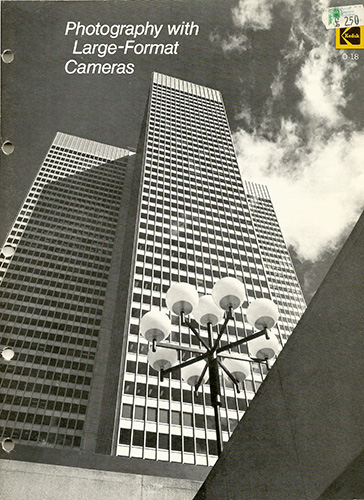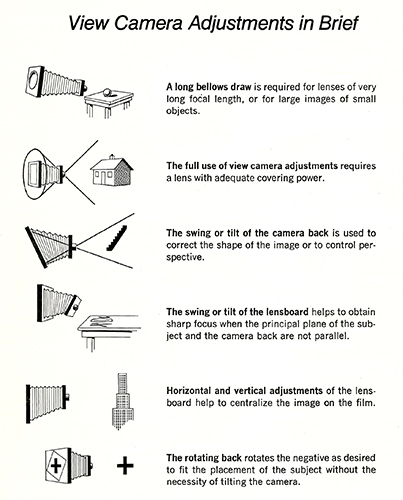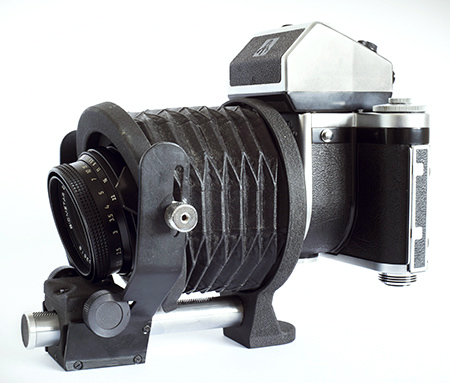by TRA
How to obtain
“View Camera” movements with a Pentacon Six
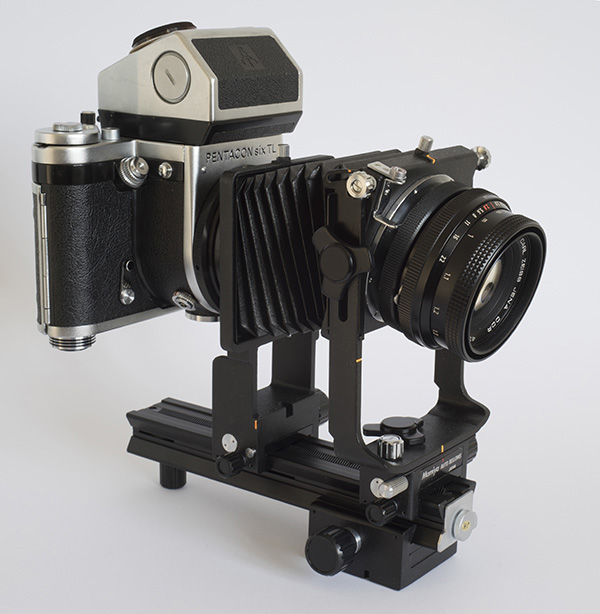
Can the Pentacon Six have the movements
of a view camera? Here’s one that has them!
[M64507.jpg]
Already in 1964, in the first edition of
his books on the Praktisix/Pentacon Six, Dr W G Heyde
wrote of the desirability of having for the camera
bellows with all the movements and alignment
possibilities (“Verstellbarkeiten”) of a “studio” or “view”
camera of the time (an “Atelier-kamera”). Such a
“view camera” has extremely flexible movements, at
least of the front standard (the lens holder) and
sometimes of the rear standard (the film
holder). View cameras are typically made in
formats of 4×5 in (or 9×12 cm) and larger. The
two main types are generally considered to be the
flatbed type and the monorail type. A 4×5
monorail camera can be seen here.
Other variants are sometimes called “field camera”,
“studio camera” or “technical camera”.
In a “studio” or “view” camera,
- movements of the front standard (which holds the lens) affect composition and depth of field.
- Movements of the rear standard (which holds the film) can change the shape of the image recorded on the film or control perspective, for instance, to reduce distortion.
In addition, raising the rear standard has the same effect as lowering the front standard, and vice versa, and both can be used, where available, to increase the total range of movement, subject to the covering power of the lens.
Typical
movements
Typical movements of such
a camera, and the terms used to describe them, are:
Front standard
- Rise/fall: up/down movement of the lens board, while remaining parallel to the back. This can help to centralise an image on the film without needing to tilt the camera up or down, which would introduce distortion.
- Shift: horizontal movement to left or to the right, while remaining parallel to the back. Like the rise-fall movement, the shift can help to centralise the image if it is not possible to locate the camera exactly opposite the object being photographed.
- Tilt: vertical movement of the lens on a horizontal axis to tilt the lens up or down. This changes the in-focus plane. This is generally used to increase the depth of the image that is in focus. It is particularly helpful with macro photography where the subject is lower than the camera and in a different plane, for instance, when the camera back is vertical but the subject is on a horizontal surface such as a table top, or plant leaves on the surface of a pond.
- Swing: horizontal movement of the lens on a vertical axis to point the lens to the left or the right. Like tilt, this changes the in-focus plane.
Rear standard
Depending on the design
of the camera, all of the above movements may be
available, or some of them or none.
Also, the rear standard may take a rotating back,
so that a non-square format can be put in either
horizontal (“landscape”) or vertical (“portrait”)
orientation.
Introduction
to View Camera Photography
| Heyde’s technical
bellows Heyde described and illustrated bellows with such movements that had been made for him to order. He recommended the use of a lens between 105 and 150mm focal length used as the normal lens for a 9 × 12 camera. (“Praktisix Buch” p. 126) He also continued to report on this in the three editions of his subsequent book, “Pentaconsix Praxis” (1st & 2nd editions, pp 264-5, 3rd edn, pp 223-4), although with no further developments of the accessory. Information on Dr Heyde’s books can be seen here. However, no such bellows were ever produced by Pentacon for the Praktica/Pentacon Six. |
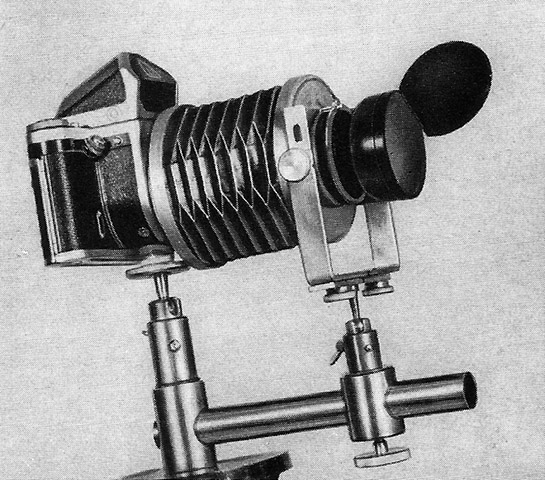 [heydebalg2.jpg]
|
|
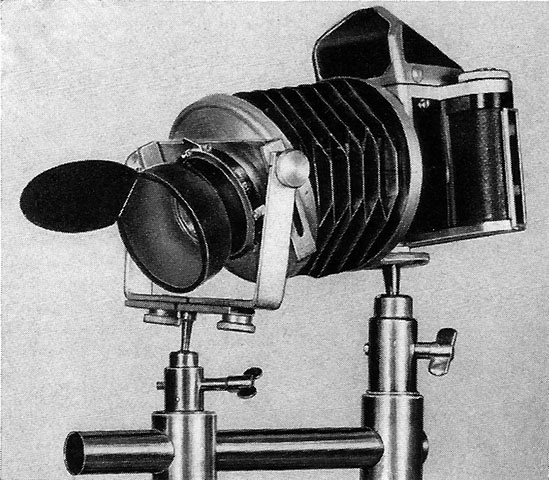 [heydebalg1.jpg] |
|
| Modification to Pentacon
Six bellows Over the years, I have seen various modified versions of the Pentacon Six bellows. To the right we see one such modification, with the front standard here raised and the standard 80mm Biometar tilted down. The unmodified Pentacon Six bellows, can be seen here.
|
|
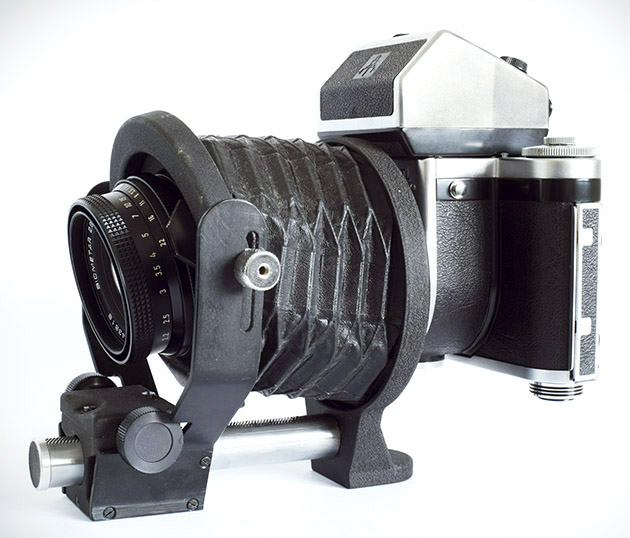 [p6balgr.jpg] |
| The Mamiya M645 Auto Bellows N |
||
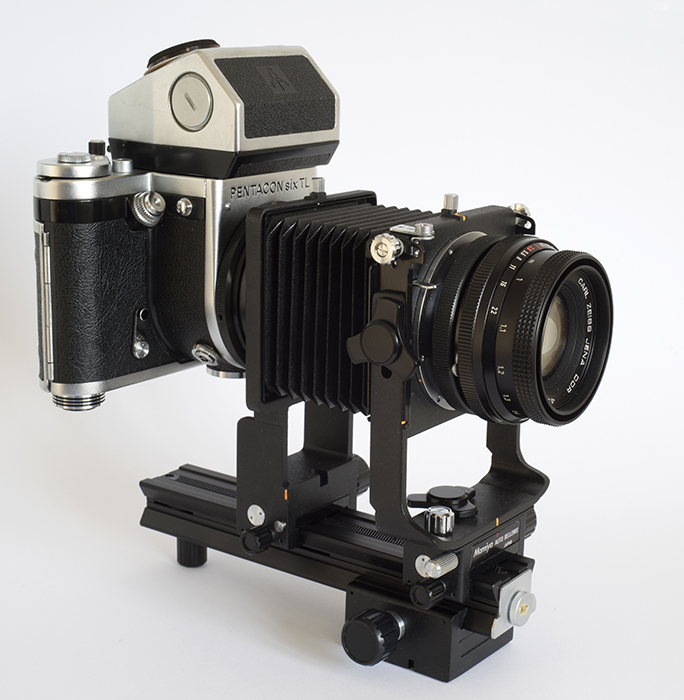 All settings
other than bellows extension at zero
[M64501.jpg] |
||
| These bellows were made by Mamiya for
their 6×4.5 cameras. As the camera mount
can be easily rotated through 90º for horizontal
or vertical shots with their cameras, the format
covered by the bellows is fully adequate for the
6×6 format of the Pentacon Six. Mamiya’s bellows unit has a highly flexible bellows section that does not hinder the full movements that are possible with the unit. Adapter rings to enable Pentacon Six lenses to be used on Mamiya 645 cameras are not difficult to find on-line, and one of these can be added to the front of the bellows, while the rear Mamiya camera mount is easy to remove from the bellows, and can be replaced with a Pentacon Six camera mount. I bought my camera mount on-line, but it would also be possible to modify a short Pentacon Six extension tube for this purpose. Heyde’s bespoke bellows did offer some movements (but not all!) for both standards, but the Mamiya bellows only have movements for the front standard (plus a rotating back). Remember that tilting the rear standard, where it is an option, can be used to reduce or eliminate distortion (see above). However, we should recall that when we look up at a tall building, our minds expect the top to look narrower than the bottom, and if this natural effect is fully corrected (for instance, by tilting the rear standard, in cases where this is an option), our minds will interpret this to mean that the top of the building actually sprouts out and is progressively wider than the base. (See here on the benefits of allowing some “Residual Perspective”.) So what is most useful is movements for the front standard, which is what the Mamiya bellows provide. We next show some of the movements that are possible with these bellows, and comment on suitable lenses. Shift and tilt lenses replicate most of these movements. See here and here. |
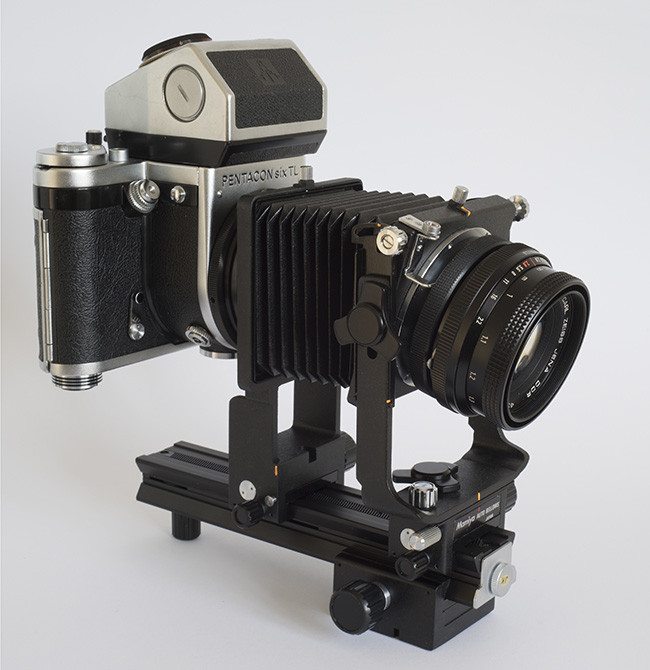 Front tilt down [M64502.jpg] |
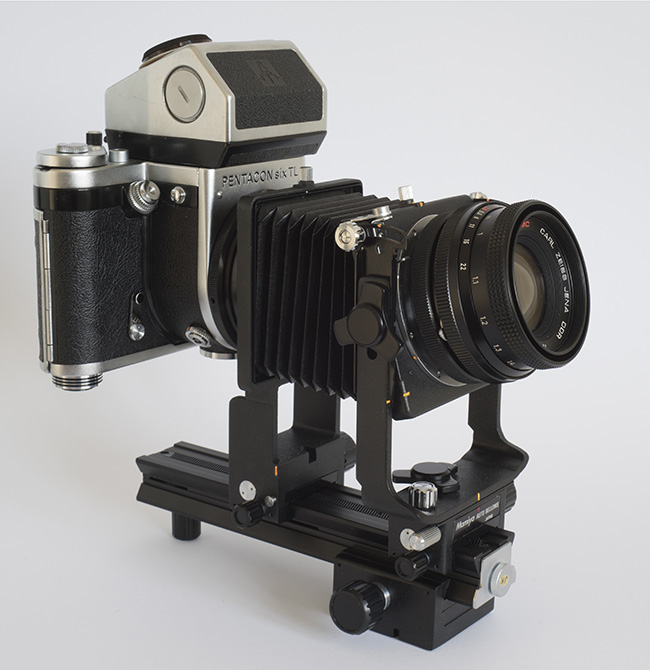 Front tilt up [M64504.jpg] |
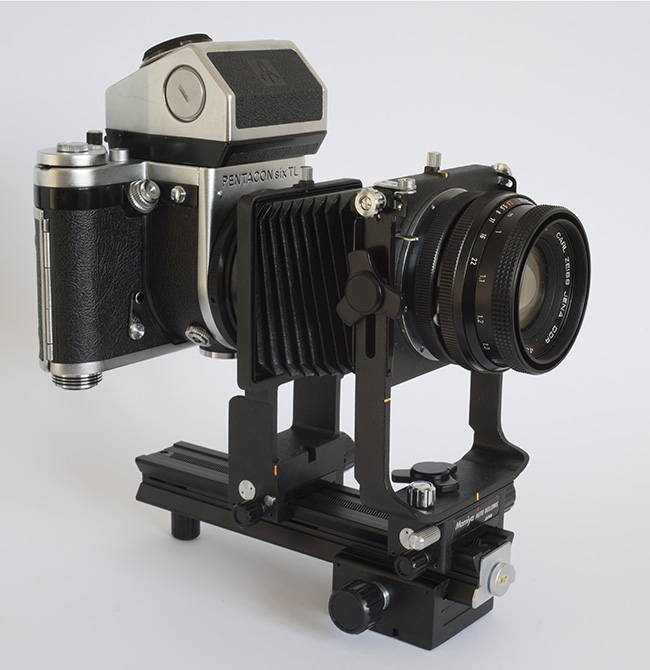 Front rise [M64505.jpg] |
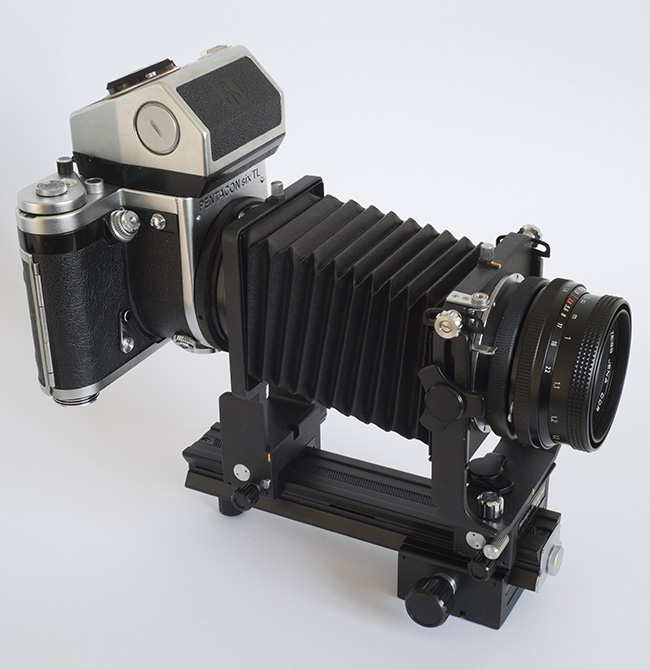 Front fall [M64506.jpg] |
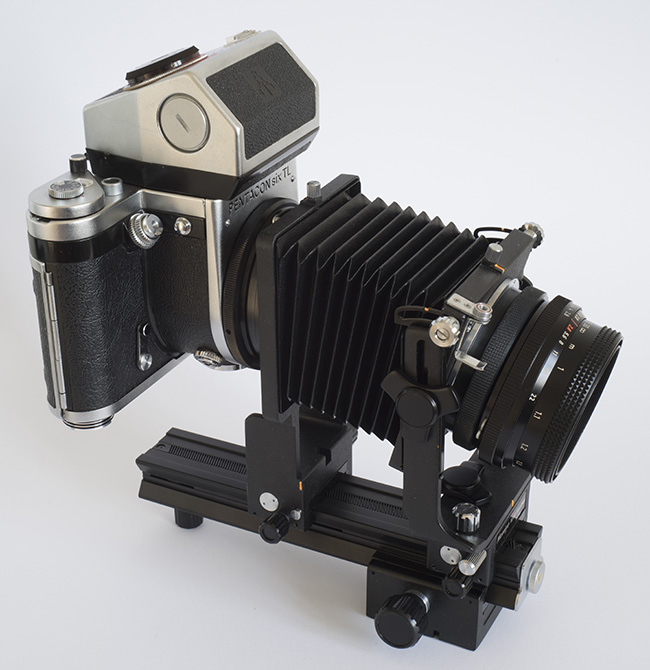 Front fall + tilt down [M64508.jpg] |
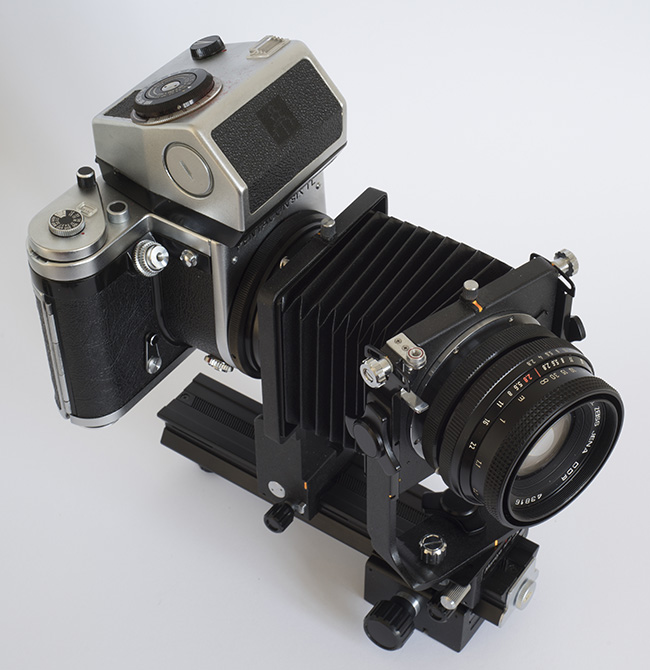 Front swing right [M64510.jpg] |
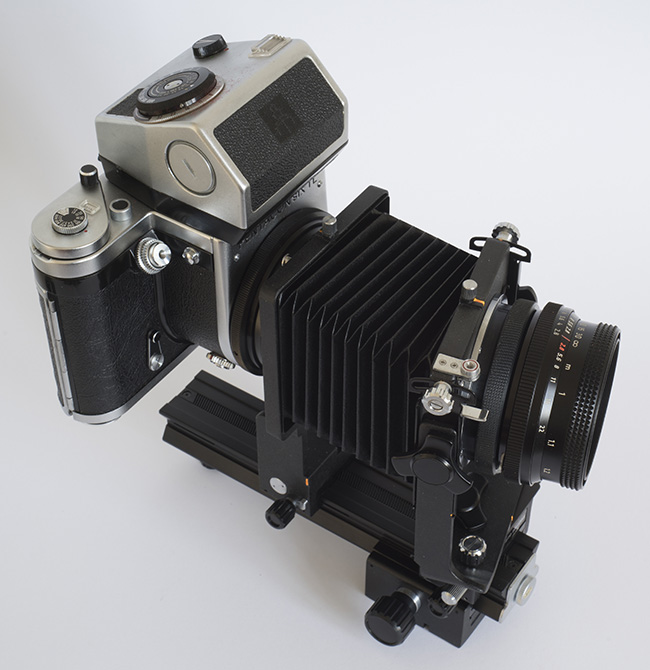 Front swing left [M64511.jpg] |
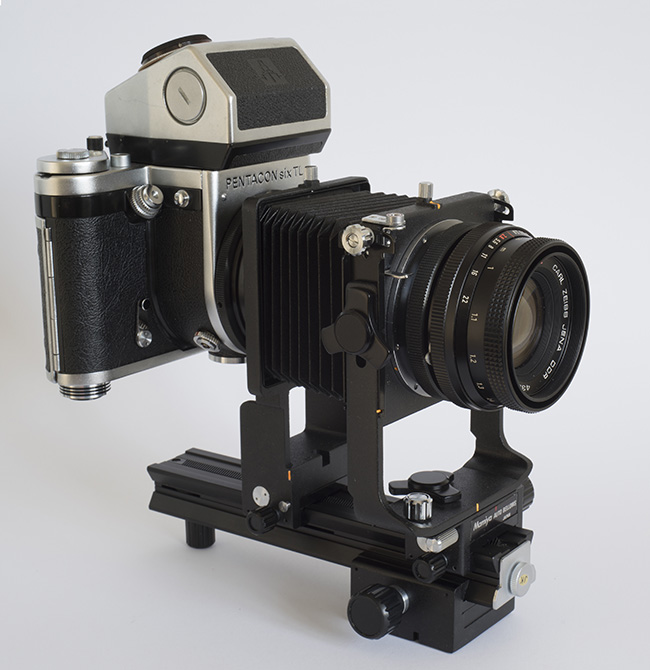 Front shift right [M64512.jpg] |
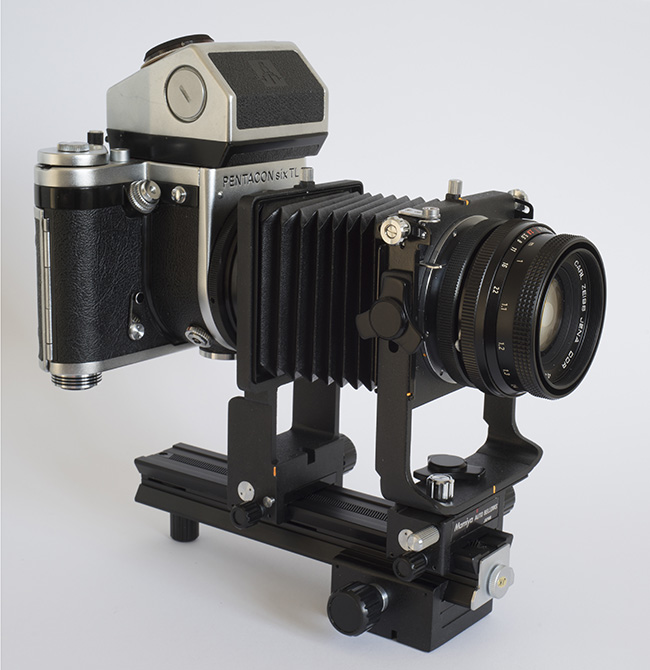 Front shift left [M64513.jpg] |
| This
movement is not particularly easy to see, but note
the position of the orange vertical line at the
the mid point of the base of the front standard,
in relation to the small red index mark below it. |
||
The above pictures are samples of possible movements. Likewise, the extent of the tilt, swing, rise/fall or shift can be varied according to requirements. The image at the top of this page illustrates rise of the front standard plus tilt down of the lens. Of course, using a standard Pentacon Six lens, infinity focus is not possible. However, for macro work this is not a problem, and the lens standard movements can be fully used to increase depth of field. Also, in macro photography normal Pentacon Six lenses project an image that is larger than when they are mounted directly onto the camera, so most movements should be possible without any fall-off in image brightness or resolution. Lenses for infinity focus designed for larger-format cameras If one needs infinity focus, a lens for a larger format is required, and here I show the two Schneider Xenar lenses that were available from Novoflex with an adapter for the Pentacon Six (see here). As such lenses also project a larger image, they generally provide adequate coverage for the full use of movements, even at infinity setting, without any fall-off in image brightness or resolution. However, the above Kodak publication points out that for many lenses “the maximum angle of view of which these lenses are capable can be realized only when they are stopped down to a relatively small aperture.” (p. 9) |
||
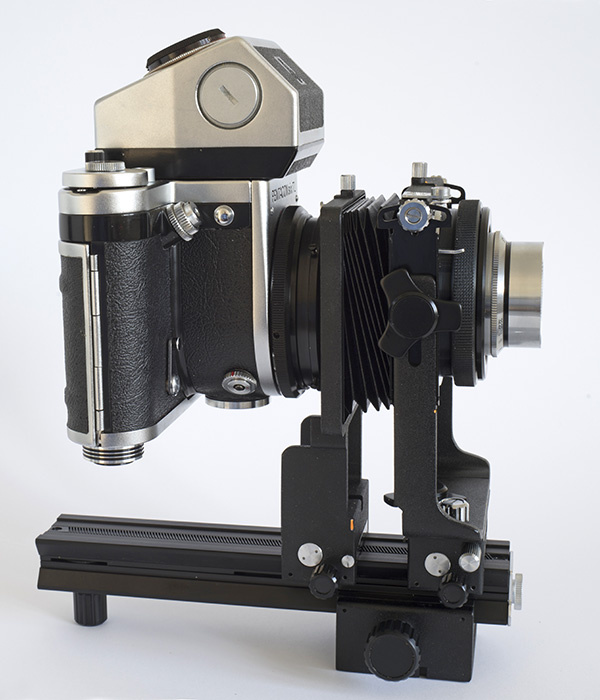 [M64516.jpg] |
|
Here
we can see the Schneider Kreuznach 150mm Xenar
lens set at infinity focus. We have raised
the front, a setting that could be suitable when
photographing tall buildings – obviously
from an appropriate distance, which will also
help to reduce perspective distortion. View cameras are of course not used hand-held, but on a sturdy tripod, and for any work with bellows on the Pentacon Six a tripod is strongly advised, even when working at infinity. For macro work it is of course essential. When the lens is stopped down to a relatively small aperture, as advised in the Kodak publication, exposure times can be long, which again makes the use of a tripod unavoidable. |
| The 180mm Xenar requires a slightly
greater extension of the bellows in order to
achieve infinity focus, but this makes all the
movements of the bellows unit easily available. |
||||
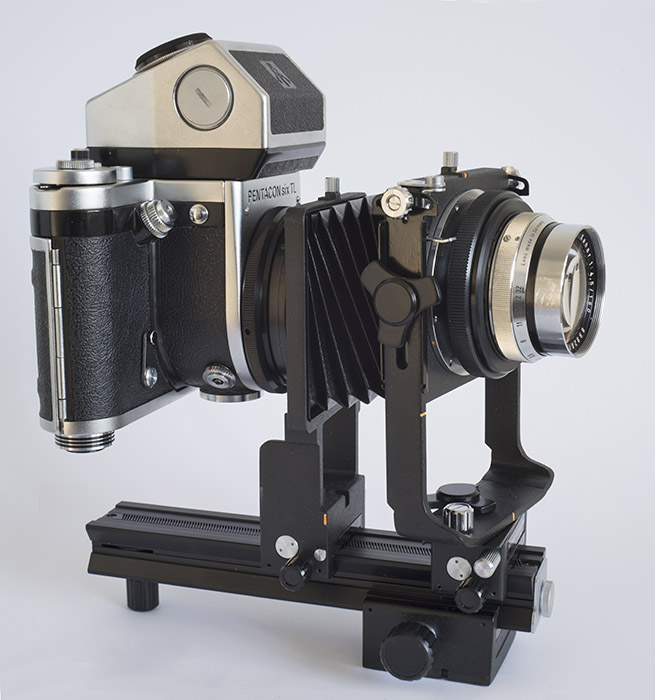 The 180mm Schneider Xenar lens at infinity focus with front rise & swing to the right [M64517.jpg] |
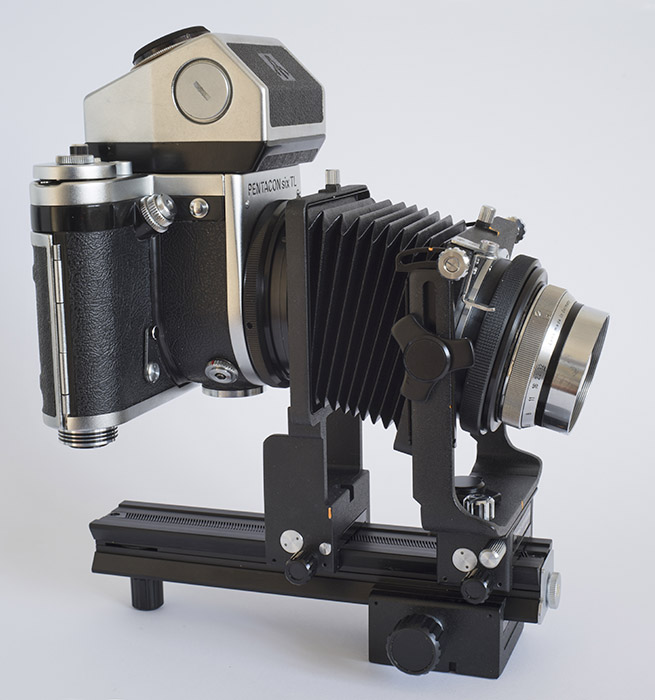 The 180mm Schneider Xenar lens at infinity focus with front fall plus tilt down [M64518.jpg] |
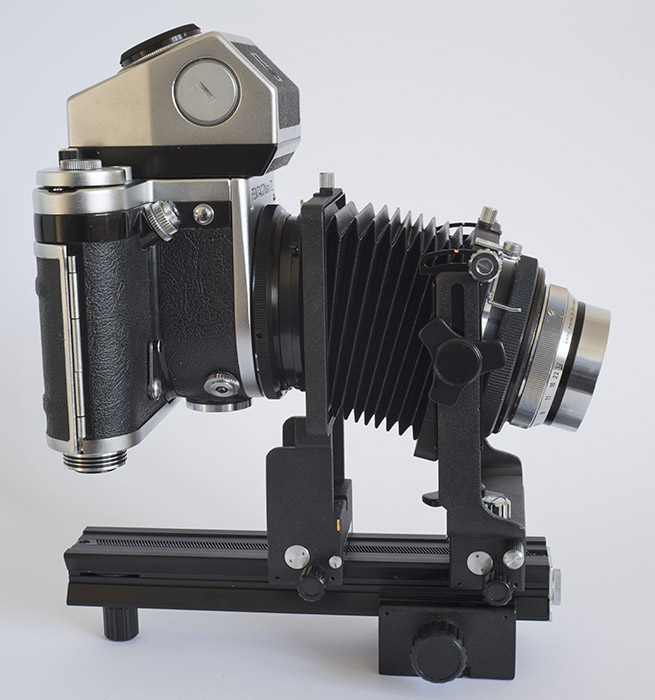 The 180mm Schneider Xenar at infinity focus again with front fall plus tilt down, viewed from a different angle [M64519.jpg] |
||
Obviously a lens with a
shorter focal length may be desirable for some
situations, and such lenses are available.
Mamiya even offered “balloon bellows” for use on their
bellows unit when extremely wide-angle lenses were
used.
To go on to the next
section, click below.
Next section (Close-up Tubes)
To go back to the
introduction to macro photography, click here.
Click the following link to go on to the Lens Test section.
© TRA October 2019, revised
September 2021
